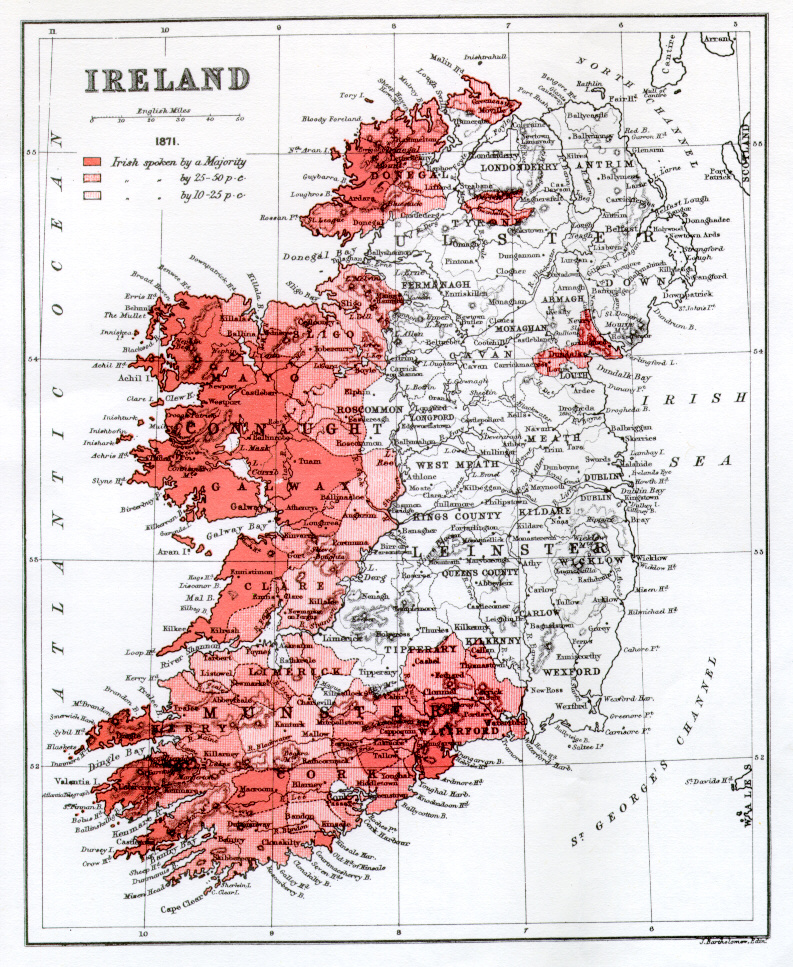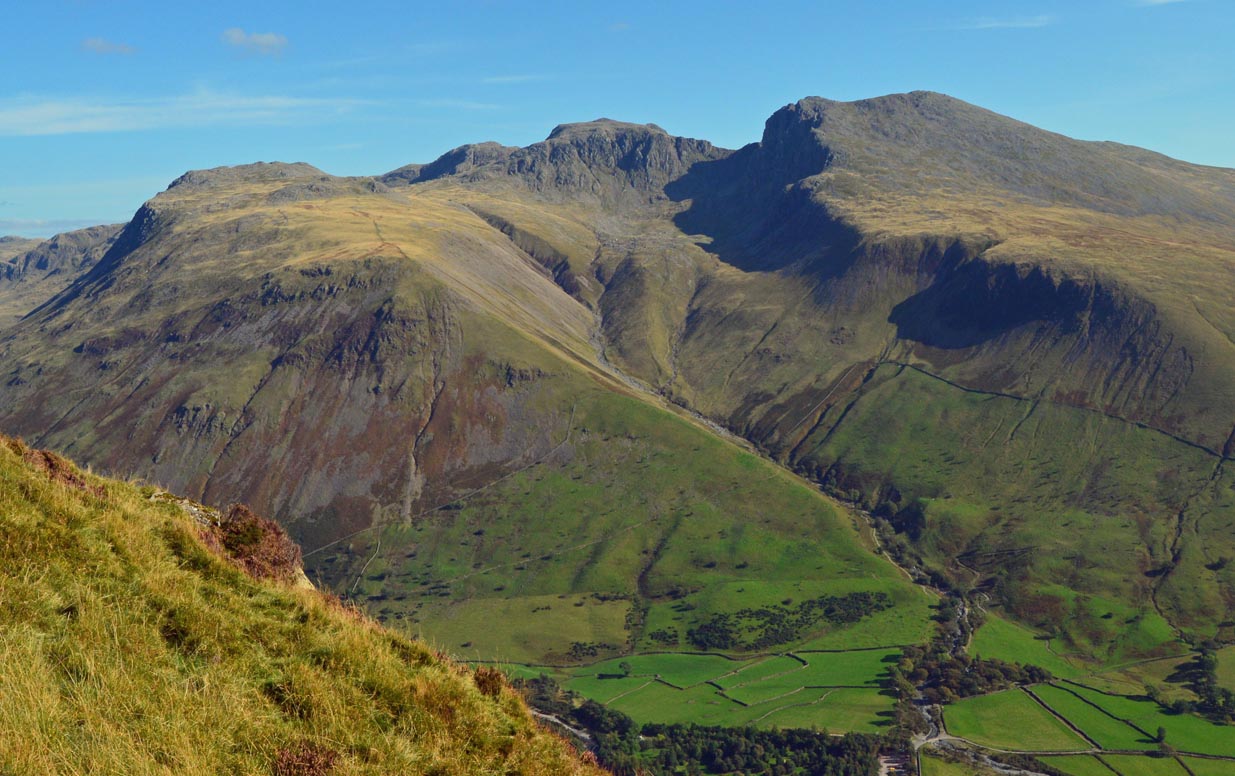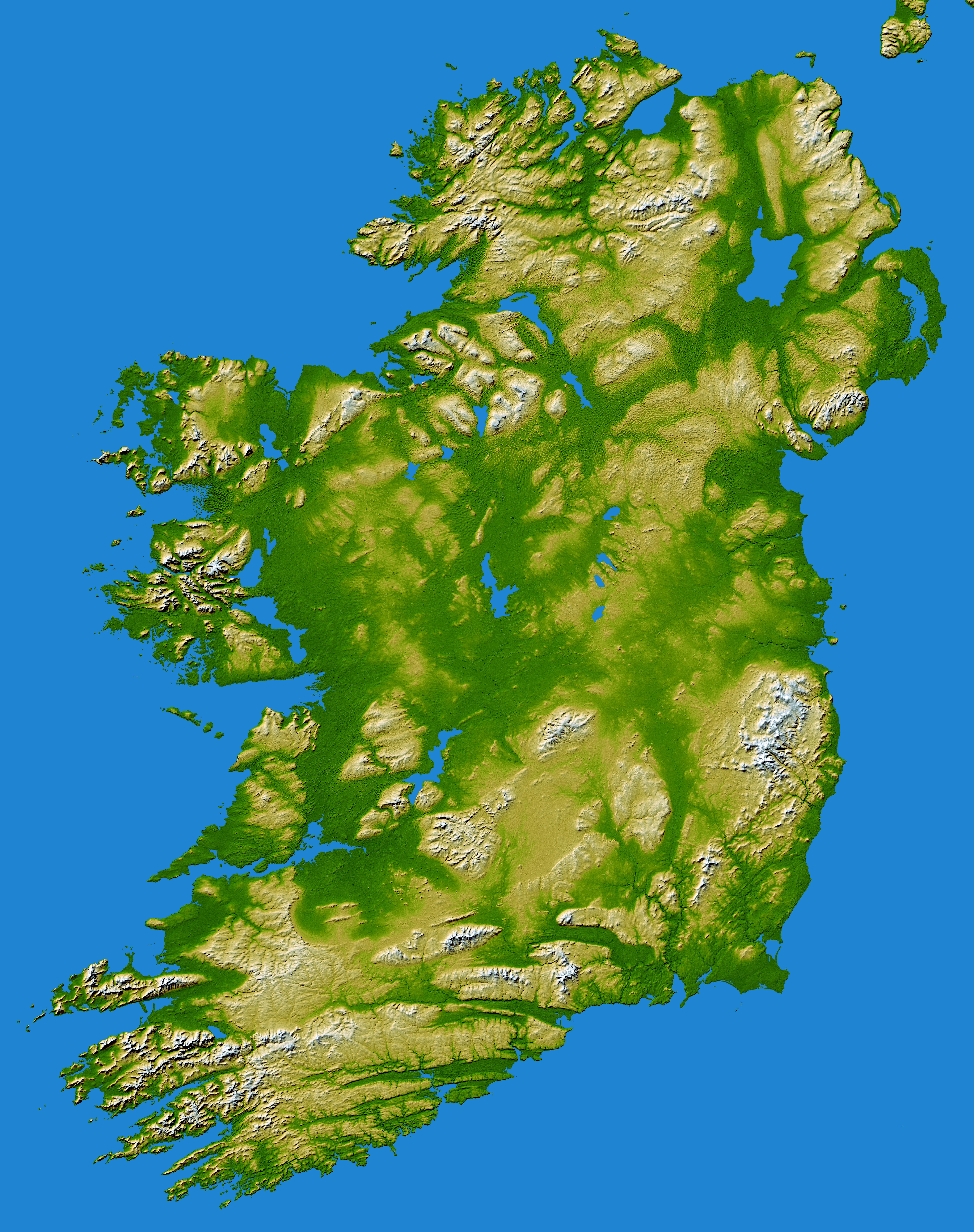|
Caherconree Fort
Caherconree () at , is the 20th–highest peak in Ireland on the Arderin scale, and the 27th–highest peak on the Vandeleur-Lynam scale.Mountainviews, (September 2013), "A Guide to Ireland's Mountain Summits: The Vandeleur-Lynams & the Arderins", Collins Books, Cork, Caherconree is the 2nd-highest mountain in the Slieve Mish Mountains in the Dingle Peninsula in Kerry, Ireland, and one of its southerly spurs is the site of an ancient stone promontory fort, which is a protected National Monument. Naming In Irish academic Paul Tempan's ''Irish Hills and Mountain Names'', the name derives from Cú Roí mac Daire, the legendary king of Munster who features in many Irish folklore tales including those concerning Cú Chulainn and Bláthnat. Geography Caherconree is the 2nd-highest mountain of the Slieve Mish range, which is situated at the eastern-end of the Dingle Peninsula, in Kerry. Caherconree is part of a "horseshoe" of the largest peaks in the Slieve Mish range that bou ... [...More Info...] [...Related Items...] OR: [Wikipedia] [Google] [Baidu] |
Irish Language
Irish (an Caighdeán Oifigiúil, Standard Irish: ), also known as Gaelic, is a Goidelic languages, Goidelic language of the Insular Celtic branch of the Celtic language family, which is a part of the Indo-European languages, Indo-European language family. Irish is indigenous language, indigenous to the Ireland, island of Ireland and was the population's first language until the 19th century, when English (language), English gradually became Linguistic imperialism, dominant, particularly in the last decades of the century. Irish is still spoken as a first language in a small number of areas of certain counties such as County Cork, Cork, County Donegal, Donegal, County Galway, Galway, and County Kerry, Kerry, as well as smaller areas of counties County Mayo, Mayo, County Meath, Meath, and County Waterford, Waterford. It is also spoken by a larger group of habitual but non-traditional speakers, mostly in urban areas where the majority are second language, second-language speakers. ... [...More Info...] [...Related Items...] OR: [Wikipedia] [Google] [Baidu] |
Baurtregaum
Baurtregaum () at , is the 13th–highest peak in Ireland on the Arderin scale, and the 18th–highest peak on the Vandeleur-Lynam scale.Mountainviews, (September 2013), "A Guide to Ireland's Mountain Summits: The Vandeleur-Lynams & the Arderins", Collins Books, Cork, Baurtregaum is situated at the centre of the massif of the Slieve Mish Mountains in the Dingle Peninsula in Kerry, Ireland, and is the tallest mountain of the Slieve Mish range, with a number of major subsidiary summits. Naming According to Irish academic Paul Tempan, the "three hollows" in the Irish name are probably the valleys of Derrymore (north), Derryquay (north-east) and Curraheen (east), which cut into the sides of the mountain. Geography Baurtregaum is the highest mountain of the Slieve Mish range, which is situated on the eastern end of the Dingle Peninsula, in Kerry. It is connected by a western ridge to the 2nd-highest peak in the range, Caherconree . Baurtregaum has several subsidiary peaks inc ... [...More Info...] [...Related Items...] OR: [Wikipedia] [Google] [Baidu] |
DoBIH
The mountains and hills of the British Isles are categorised into various lists based on different combinations of elevation, prominence, and other criteria such as isolation. These lists are used for peak bagging, whereby hillwalkers attempt to reach all the summits on a given list, the oldest being the 282 Munros in Scotland, created in 1891. A height above 2,000 ft, or more latterly 610 m, is considered necessary to be classified as a mountain – as opposed to a hill – in the British Isles. With the exception of Munros, all the lists require a prominence above . A prominence of between (e.g. some Nuttalls and Vandeleur-Lynams), does not meet the International Climbing and Mountaineering Federation (UIAA) definition of an "independent peak", which is a threshold over . Most lists consider a prominence between as a "top" (e.g. many Hewitts and Simms). Marilyns, meanwhile, have a prominence above , with no additional height threshold. They range from small hill ... [...More Info...] [...Related Items...] OR: [Wikipedia] [Google] [Baidu] |
List Of Hewitt Mountains In England, Wales And Ireland
This is a list of Hewitt mountains in England, Wales and Ireland by height. Hewitts are defined as "Hills in England, Wales and Ireland over two thousand" feet in height, the general requirement to be called a "mountain" in the British Isles, and with a prominence above ; a mix of imperial and metric thresholds. The Hewitt classification was suggested by Alan Dawson in his 1992 book, "The Relative Hills of Britain". Dawson originally called his Hewitts "Sweats", from "Summits - Wales and England Above Two thousand", before settling on the label Hewitt. In a series of three booklets edited by Dave Hewitt, the list of English Hewitts was published in 1997, and the list of Welsh Hewitts was also published in 1997, and the list of Irish Hewitts was published in 1998. Hewitts were designed to address one of the criticisms of the 1990 Nuttall classification, by requiring hills to have a relative height of , a threshold that the UIAA had set down in 1994 for an "independen ... [...More Info...] [...Related Items...] OR: [Wikipedia] [Google] [Baidu] |
Lists Of Mountains And Hills In The British Isles
The mountains and hills of the British Isles are categorised into various lists based on different combinations of elevation, prominence, and other criteria such as isolation. These lists are used for peak bagging, whereby hillwalkers attempt to reach all the summits on a given list, the oldest being the 282 Munros in Scotland, created in 1891. A height above 2,000 ft, or more latterly 610 m, is considered necessary to be classified as a mountain – as opposed to a hill – in the British Isles. With the exception of Munros, all the lists require a prominence above . A prominence of between (e.g. some Nuttalls and Vandeleur-Lynams), does not meet the International Climbing and Mountaineering Federation (UIAA) definition of an "independent peak", which is a threshold over . Most lists consider a prominence between as a "top" (e.g. many Hewitts and Simms). Marilyns, meanwhile, have a prominence above , with no additional height threshold. They range from small hills to ... [...More Info...] [...Related Items...] OR: [Wikipedia] [Google] [Baidu] |
List Of Mountains In Ireland
In these lists of mountains in Ireland, those within Northern Ireland, or on the Republic of Ireland – United Kingdom border, are marked with an asterisk, while the rest are within the Republic of Ireland. Where mountains are ranked by height, the definition of the topographical prominence used to classify the mountain (e.g. the change in elevation required between neighbouring mountains), is noted. In British definitions, a height of is required for a mountain, whereas in Ireland, a lower threshold of is sometimes advocated. The lowest minimum prominence threshold of any definition of an Irish mountain is (e.g. the Vandeleur-Lynam), however most definitions, including the International Climbing and Mountaineering Federation (UIAA) criteria, do not consider prominences below as being mountains (e.g. must at least be an Arderin or a Hewitt). Many British definitions consider a peak with a prominence below , as being a ''top'', and not a mountain (e.g. must be a Marilyn) ... [...More Info...] [...Related Items...] OR: [Wikipedia] [Google] [Baidu] |
Fionn Mac Cumhaill
Fionn mac Cumhaill ( ; Old and mga, Find or ''mac Cumail'' or ''mac Umaill''), often anglicized Finn McCool or MacCool, is a hero in Irish mythology, as well as in later Scottish and Manx folklore. He is leader of the '' Fianna'' bands of young roving hunter-warriors, as well as being a seer and poet. He is said to have a magic thumb that bestows him with great wisdom. He is often depicted hunting with his hounds Bran and Sceólang, and fighting with his spear and sword. The tales of Fionn and his ''fiann'' form the Fianna Cycle or Fenian Cycle (''an Fhiannaíocht''), much of it narrated by Fionn's son, the poet Oisín. Etymology In Old Irish, finn/find means "white, bright, lustrous; fair, light-hued (of complexion, hair, etc.); fair, handsome, bright, blessed; in moral sense, fair, just, true". It is cognate with Primitive Irish ''VENDO-'' (found in names from Ogam inscriptions), Welsh ''gwyn'', Cornish ''gwen'', Breton ''gwenn'', Continental Celtic and Commo ... [...More Info...] [...Related Items...] OR: [Wikipedia] [Google] [Baidu] |
Cú Roí
Cú Roí mac Dáire (Cú Ruí, Cú Raoi) is a king of Munster in the Ulster Cycle of Irish mythology. He is usually portrayed as a warrior with superhuman abilities and a master of disguise possessed of magical powers. His name probably means "hound of the plain/field", or more specifically, "hound of the battlefield". He is the son of Dáire mac Dedad (or Dáire Doimthech), and thus belongs to the Clanna Dedad. However, T. F. O'Rahilly believed this to be artificial, stating that "Cú Roí and Dáire are ultimately one and the same". Though often an outsider figure, for instance in the role of intervener or arbitrator, Cú Roí appears in a great number of medieval Irish texts, including '' Forfess Fer Fálgae'', ''Amra Con Roi'', ''Brinna Ferchertne'', ''Aided Chon Roi'' (in several recensions), '' Fled Bricrenn'', '' Mesca Ulad'' and ''Táin Bó Cúailnge''. The early Irish tale-lists refer to such titles as '' Aided Chon Roí'', ''Echtra Chon Roí'' (List A), ''Orgain Cha ... [...More Info...] [...Related Items...] OR: [Wikipedia] [Google] [Baidu] |
Irish Mythology
Irish mythology is the body of myths native to the island of Ireland. It was originally passed down orally in the prehistoric era, being part of ancient Celtic religion. Many myths were later written down in the early medieval era by Christian scribes, who modified and Christianized them to some extent. This body of myths is the largest and best preserved of all the branches of Celtic mythology. The tales and themes continued to be developed over time, and the oral tradition continued in Irish folklore alongside the written tradition, but the main themes and characters remained largely consistent. The myths are conventionally grouped into ' cycles'. The Mythological Cycle consists of tales and poems about the god-like Túatha Dé Danann, who are based on Ireland's pagan deities, and other mythical races like the Fomorians. Important works in the cycle are the '' Lebor Gabála Érenn'' ("Book of Invasions"), a legendary history of Ireland, the '' Cath Maige Tuired' ... [...More Info...] [...Related Items...] OR: [Wikipedia] [Google] [Baidu] |
Irish Times
''The Irish Times'' is an Irish daily broadsheet newspaper and online digital publication. It launched on 29 March 1859. The editor is Ruadhán Mac Cormaic. It is published every day except Sundays. ''The Irish Times'' is considered a newspaper of record for Ireland. Though formed as a Protestant nationalist paper, within two decades and under new owners it had become the voice of British unionism in Ireland. It is no longer a pro unionist paper; it presents itself politically as "liberal and progressive", as well as being centre-right on economic issues. The editorship of the newspaper from 1859 until 1986 was controlled by the Anglo-Irish Protestant minority, only gaining its first nominal Irish Catholic editor 127 years into its existence. The paper's most prominent columnists include writer and arts commentator Fintan O'Toole and satirist Miriam Lord. The late Taoiseach Garret FitzGerald was once a columnist. Senior international figures, including Tony Blair and B ... [...More Info...] [...Related Items...] OR: [Wikipedia] [Google] [Baidu] |
Iron Age
The Iron Age is the final epoch of the three-age division of the prehistory and protohistory of humanity. It was preceded by the Stone Age (Paleolithic, Mesolithic, Neolithic) and the Bronze Age (Chalcolithic). The concept has been mostly applied to Iron Age Europe and the Ancient Near East, but also, by analogy, to other parts of the Old World. The duration of the Iron Age varies depending on the region under consideration. It is defined by archaeological convention. The "Iron Age" begins locally when the production of iron or steel has advanced to the point where iron tools and weapons replace their bronze equivalents in common use. In the Ancient Near East, this transition took place in the wake of the Bronze Age collapse, in the 12th century BC. The technology soon spread throughout the Mediterranean Basin region and to South Asia ( Iron Age in India) between the 12th and 11th century BC. Its further spread to Central Asia, Eastern Europe, and Central Europe is somewhat ... [...More Info...] [...Related Items...] OR: [Wikipedia] [Google] [Baidu] |
R561 Road (Ireland)
The R561 road is a regional road in Ireland. It is on the Dingle Peninsula in County Kerry. Part of the road is on the Wild Atlantic Way. Inch Beach, beginning at the R561, is a wide, sandy beach long. The beach dunes have yielded archaeological remains of ancient dwelling sites. The R561 travels west from the N22 at Farranfore. The road joins the N70 from Brackhill to Castlemaine. The R561 continues west from Castlemaine along the north shore of Castlemaine Harbour to Inch and Inch Beach. The road then travels along the north shore of Dingle Bay Dingle Bay (''Bá an Daingin'' in Irish) is a bay located in County Kerry, western Ireland. The outer parts of the Dingle Peninsula and Dingle Bay mark one of the westernmost points of mainland Ireland. The harbour town of Dingle lies on th ... before joining the N86 near Annascaul. The R561 is long. References Regional roads in the Republic of Ireland Roads in County Kerry {{Ireland-road-stub ... [...More Info...] [...Related Items...] OR: [Wikipedia] [Google] [Baidu] |




_(14750481494).jpg)
.jpg)

